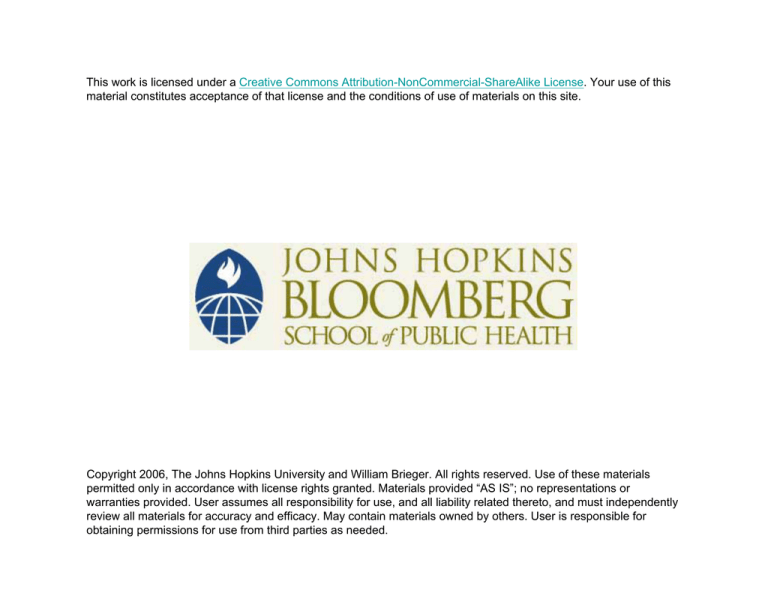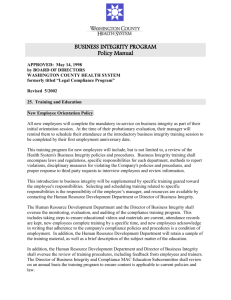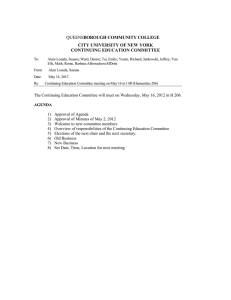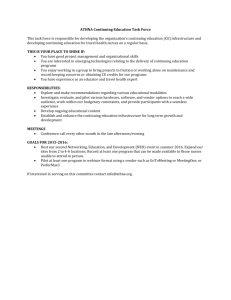
This work is licensed under a Creative Commons Attribution-NonCommercial-ShareAlike License. Your use of this
material constitutes acceptance of that license and the conditions of use of materials on this site.
Copyright 2006, The Johns Hopkins University and William Brieger. All rights reserved. Use of these materials
permitted only in accordance with license rights granted. Materials provided “AS IS”; no representations or
warranties provided. User assumes all responsibility for use, and all liability related thereto, and must independently
review all materials for accuracy and efficacy. May contain materials owned by others. User is responsible for
obtaining permissions for use from third parties as needed.
An Organizational Context for Training
William Brieger, MPH, CHES, DrPH
Johns Hopkins University
Section A
Introduction and Definitions
The Context
Continuing Education
TRAINING
Personnel Management
Organizational Management
3
Training Is
A set or series of formal learning activities
That enables future or current workers
To acquire the knowledge, skills and attitudes
Needed to perform a job
Within the workplace …
Ë In-Service Training (IST) is part of continuing
education (CE)
4
Training in the Community
While training
supports
implementation and
achievement of
organizational goals,
training is not limited
to formal employees
Community volunteers, peer educators and outreach
workers also can be trained
5
Continuing Education
CE is both formal and informal
CE helps workers revise and polish existing skills
CE helps workers obtain new skills on the job
CE keeps workers up-to-date
CE is part of
Ë Personnel or human resource management
6
Personnel Management
Obtaining, organizing, and motivating the human
resources required by the enterprise
Developing an organization climate and management
style which will promote effective effort and cooperation
and trust between all the people working in it
Source: Armstrong, 1980
Continued
7
Personnel Management
Helping the enterprise meet its legal obligations and its
social responsibilities towards its employees with regard
to the conditions of work and quality of life provided for
them
Source: Armstrong, 1980
8
Components
Personnel management: those activities within an
organization that are geared to recruiting and
maintaining high quality human resources
Cardinal function: create a workforce with the
ability/motivation to accomplish basic corporate goals
Two categories: (1) conditions of service, and (2) job
performance
9
Conditions of Service
Salary and remuneration
Location and time of work
Promotions, transfers, separation
Performance appraisal, discipline
Benefits, such as health care
Entitlements such as continuing education
Health and safety
Allowances such as hazard pay, vacations
10
Job Performance
Personnel policy defines
Ë Job descriptions and responsibilities
Ë Job qualifications
Ë Working, reporting, and supervisory relationships
Job performance is enhanced through
Ë Continuing education
Ë Supervisory feedback
11
Summary of Context
Personnel/Human
Resource Management
Conditions of Service
Salary,
Promotions
Benefits,
Allowances
Personnel Development
Discipline
Continuing
Education
In-Service Training
Self-Learning
Staff Meetings
Job Description
Supervisory Visits
Workshops
Seminars
Short Courses
12
Section B
Training in the Context of Organizational Management and
Programming
Stakeholders in Organizational Management
Organizational management must address and balance
the needs and interest of many stakeholders including:
Ë Personnel, workforce, unions
Ë Shareholders, legislators
Ë Directors, board members
Ë Customers/consumers
Ë Social interest groups, etc.
14
Organizational Performance: Employee Performance
An organization (public or private) exists and grows
because it provides the community with goods or
services the community sees as worthwhile
To do this efficiently, the organization must function at
an optimum level of productivity
Continued
15
Organizational Performance: Employee Performance
This level is a direct result of the collective effort of all
employees
Yet not every employee works at the level established by
the standard of performance for the job he or she holds
16
A Review of Organizational Diagnosis
Human
Element
Environment
Time & Space
Coordination
Technical
Policy
17
How Training Can Address Organizational Problems
18
Issues Training May Not Address
19
In Fact
It is estimated that only 15% of performance problems
can be addressed through training
The other 85% are due to problems in the system—
facilities, equipment, supplies, management procedures,
etc.
Ë Learning for Health, 1992
20
Performance Can Be Affected By
Rigid timetables
Personal unwillingness to
change
Lack of or dysfunctional
basic equipment
Heavy caseload and not
enough staff
Feelings of isolation
Inadequate referral system
Poor accommodation
Few incentives or
opportunities for
advancement
Irregular or inadequate
supplies
21
Herzberg’s Research Helps Explain
He focused on factors in the job that lead to satisfaction
or to dissatisfaction
Ë These factors include the full scope of personnel
management
The factors that employees listed as causing them
satisfaction on the job were distinctly different in nature
than those that cause dissatisfaction
22
Satisfiers
Achievement
Recognition
Note that these are
components of selfactualization
Responsibility
Work itself
Growth
Advancement
23
Dissatisfiers
Working conditions
Policies, practices
Supervision
Note that these are often
sources of conflict,
tension, worry, and
disunity
Interpersonal relations
Salary/financial compensation
Status
Job security
Personal life
24
Analysis of Factors
Satisfiers are all integral to the performance of the job
and are therefore referred to as job-content factors
Dissatisfiers have to do with the environment
surrounding the job itself and thus are referred to as jobcontext factors
Training, it would appear, addresses the satisfiers
25
Analyze before You Train
A performance gap by employees doesn’t necessarily or
directly translate into a need for continuing education or
training
Before putting resources into CE:
Ë Look at the underlying causes of problem
The lack of appropriate knowledge and skills is one case
where continuing education may be the answer
26
Other Reasons
Other reasons are related to:
Ë Lack of resources
Ë Poor motivation
Ë Poor work organization
These problems require different solutions
Ë Petit, 1994
27
Tuberculosis Patient Case Detection, Treatment,
and Holding Is below National Standards
28
Program Planning Example
WHO’s Mother-Baby Package
Program activities
Ë Strengthen health services
Ë Develop and manage human resources
Ë Assure equipment, supplies, and drugs
Ë Assure quality of care
Ë Organize health education for the community
29
Human Resource Development Includes
Improving basic training—e.g., for midwives
Deploying adequate staff at front-line and referral levels
Conducting in-service training for existing MCH staff
Obtaining legal backing for new procedures, roles of
front-line cadres
Improving conditions of service for front-line staff
30
Conclusion
When all things are considered, 15% of performance
problems and needs is not a small number
While training must be put in context of personnel and
organizational management, training also must be
addressed in a thorough and systematic manner
Organizations must, therefore, have training policies
31
Section C
Training Policy and Functions
Organization of Personnel Management
Organizations usually have departments that are
variously called
Ë Establishments
Ë Personnel
Ë Human resources
Training and continuing education units, departments,
or programs are less common
33
Legitimizing Training
IST and CE should be part of a training department/unit
within an organization
This makes it possible for training to become a planned
component of overall organizational management
As opposed to an ad hoc arrangement
34
g
gy
in Most Programs
Here a community health
committee is being trained
on mobilization for
immunization
The job of planning and
implementing training
should be a normal agency
line function
35
Institutionalizing Training
In order for the training function to be thus
institutionalized:
Ë The position of training manager and the
establishment of a training department must be
legitimized in the form of an organizational policy
Ë Training must be an entitlement
Ë A resource center is needed
36
Functions of a Training Unit
Recognize, determine organization’s training needs
Implement staff development and training according to
overall plans
Utilize training specialists to design plans for the
organization
Provide coaching (individualized training) as needed
Evaluate and plan future training
37
Training Specialist
Research and develop overall training plans
Network with outside resources
Work with management to develop appropriate
supervisory approaches
Administer and coordinate training programs
Prepare training outlines and learning materials
Train supervisors in teaching skills
Evaluate training results
38
Accountability
Training consumes resources
Ë Staff time, materials, travel costs, etc.
Ë From design through follow-up
Administrators and executives demand that a training
unit demonstrate its value
Ë Cost/benefit analysis
Ë Return on investment
39
Linkage
Trainees return to a work setting where they will apply
new knowledge and skills
Ë But will they be accepted and function?
Continued
40
Linkage
Trainers must liaise with departments to ensure that:
Ë Training needs are recognized
Ë Supervisors know what to expect from trainees
Ë Job security is maintained
Ë Trainees are rewarded appropriately
41
Ideal Training Roles
When there is a difference or gap between actual
performance and the standard, productivity suffers
Training can reduce this gap by changing the behavior of
individuals
Ë By giving them additional specific knowledge,
skills, or attitudes needed to achieve a standard
Continued
42
Ideal Training Roles
Changing behavior, then is the function of training
The ultimate objective is to help achieve the goals of the
organization through optimum use of human resources
43
Training Functions
Increase productivity
Improve the quality of work and raise morale
Develop new skills, knowledge, understanding, and
attitudes (fight obsolescence)
Use correctly new tools, machines, processes, methods,
or modifications
Continued
44
Training Functions
Reduce waste, accidents, turnover, lateness,
absenteeism, and other overhead costs
Implement new/changed policies/regulations
Develop replacements, prepare people for advancement,
improve manpower development, and ensure continuity
of leadership
High expectations for training: can training live up to
these?
45
Sample Training Activities
Orienting new employees to the goals, policies,
structure, products, or services of the organization
Acquainting employees with a new organizational policy
and how it is to be implemented
Continued
46
Sample Training Activities
Familiarizing employees with a new procedure, new
record form, a new machine, or a modification of existing
forms, machines, etc.
Improving the quality of information management and
report writing throughout the organization
47
Section D
Continuing Education
Continuing Education
Combating continuing ignorance
Ë Help in remembering basic learning
Ë Job realities that were never taught in school
Ë Job changes due to new circumstances and
technologies
Ë CE is a lifelong process
49
of Continuing Ignorance?
Health workers in isolated settings
Ë With few supervisory visits
Ë Inadequate or lack of reading materials
Ë Less opportunity to attend meetings, seminars
Ë Interact with fewer professional colleagues
50
CE Strategies
Staff meetings within the workplace
Meetings with professional colleagues at seminars,
conferences, workshops
On-site supervision and coaching
Self-study with books, journals, distance education
Radio and mass media programs
Exchange visits
Formal in-service training courses
51
A Study of CE in Nigeria
Rural Ibarapa District, Oyo State
Approximately 160,000 residents
165 health workers
Ë 33% local government
Ë 35% state, federal government
Ë 32% private facilities
Continued
52
A Study of CE in Nigeria
Interviewed about CE experiences in:
Ë IST
Ë Supervision
Ë Staff meetings
Ë Self-study
53
Number
CE Experiences: 144 Respondents
120
100
80
60
40
20
0
98
104
Super <
6mos
Staff
Meet
<6mos
84
56
IST
Self
Study
Type of CE
54
CE Experiences by Sector
70
60
50
40
30
20
10
0
IST
Super <
6mos
Local
Staff
Meet
<6mos
State/Fed
Self
Study
Private
55
CE Experiences and Gender
100
80
60
40
20
0
IST
Super <
6mos
Male
Staff
Meet
<6mos
Self
Study
Female
56
Lessons
Government health staff have greater access to IST
Many donor programs sponsor IST
Policymakers forget that private sector provides large
share of services
Private sector staff needs updating, too, on new
treatment procedures, etc.
Copyright 2005, Bill Brieger and The Johns Hopkins University. All rights reserved. Use of these materials
permitted only in accordance with license rights granted. Materials provided “AS IS”; no representations or
warranties provided. User assumes all responsibility for use, and all liability related thereto, and must
independently review all materials for accuracy and efficacy. May contain materials owned by others. User
is responsible for obtaining permissions for use from third parties as needed. Unless otherwise stated, all
photos are the property of Bill Brieger.
57




